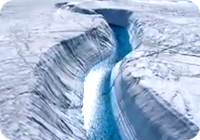Created specifically for, and presented to world leaders at the 2014 United Nations Climate Summit in New York, this cool short film portrays climate change as a challenging, but solvable problem. Written by Scott Z. Burns, and produced by Lyn Davis Lear, it features the narration of none other than Morgan Freeman and stirring music by composer Hans Zimmer. Its hopeful tone reminds me of the reboot of Cosmos which recently aired on FOX which also dealt in-part with global warming.
By itself, ‘What’s Possible’ is just a single, small step on our journey to dealing with man-made climate change. Hopefully, the world leaders who experienced it, understood its message and what it means for future generations. Time is growing ever-shorter to deal with climate change which will surely be humanity’s defining challenge for the next 50 years. As Carl Sagan said in his famous essay The Pale Blue Dot:
“The Earth is the only world known, so far, to harbor life. There is nowhere else, at least in the near future, to which our species could migrate. Visit, yes. Settle, not yet. Like it or not, for the moment, the Earth is where we make our stand.”
Will our species stand up as Carl said, or will we continue to be consumed with short-term monitory greed and political posturing? I prefer to think we’ll come to our senses and do, not only what’s possible, but what’s right.
 While the battle rages between climate deniers and the
While the battle rages between climate deniers and the